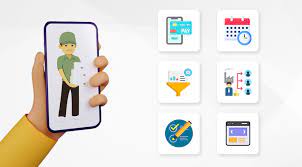In today’s ultra-competitive digital economy, speed and convenience are no longer optional—they’re expected. Whether it’s groceries, meals, parcels, or medicine, users want everything delivered fast, reliably, and on demand. This consumer shift has triggered a massive wave in delivery app adoption, with businesses across industries now realizing the value of custom-built solutions.
If you have a vision for launching your delivery platform, 2025 is the perfect time to transform it into reality. In this guide, we’ll walk you through the key steps to build a custom delivery app that’s not only functional—but scalable, future-ready, and built around your unique business needs.
Why Build a Custom Delivery App in 2025?
Unlike off-the-shelf solutions, a custom delivery app gives you complete control over features, design, workflows, and customer experience. Here’s why it matters:
- Tailored to your industry and audience
- Better scalability as your business grows
- Integrates with your existing tech stack
- Data ownership and enhanced security
- Brand-specific UI/UX for consistent identity
Whether you’re a startup disrupting logistics or a retail brand looking to streamline deliveries, a custom app helps you deliver more than just orders—it helps you deliver value.
Step 1: Define Your Business Model
Start by outlining the delivery model your app will follow. Common ones include:
- Single Vendor App: For businesses that deliver their products (e.g., bakery, pharmacy)
- Multi-Vendor Marketplace: Aggregates multiple sellers/vendors (e.g., Uber Eats, Instacart)
- Logistics/Courier Platform: Ideal for P2P or B2B parcel delivery
- Hyperlocal Delivery: Focuses on delivering within small geographical areas
- Subscription-Based Delivery: Milk, groceries, or meal plans regularly
Tip: Align your model with your niche and logistics capability.
Step 2: Outline Must-Have Features
A successful delivery app is made of three main components: a Customer App, a Delivery Agent App, and an Admin Panel. Here’s what each should include:
Customer App:
- User registration & profile management
- Product/vendor browsing
- Order placement & customization
- Real-time tracking & ETAs
- Multiple payment options
- Notifications and status updates
- Ratings, reviews, and support
Delivery Agent App:
- Delivery request management
- Order pickup/drop navigation
- Availability toggle
- Delivery history and earnings
- In-app chat/call with customers
Admin Dashboard:
- Order management and status control
- Vendor/delivery agent management
- Analytics & reports
- Offers, discounts, and loyalty programs
- Support and issue resolution tools
Step 3: Choose the Right Tech Stack
In 2025, your app should be built using scalable, modern, and secure technologies. Here’s a recommended tech stack:
- Frontend: Flutter or React Native (for cross-platform apps)
- Backend: Node.js, Django, or Laravel
- Database: PostgreSQL or MongoDB
- Real-Time Tracking: Firebase, WebSockets, Google Maps API
- Cloud Infrastructure: AWS, Google Cloud, Azure
- Payment Integration: Stripe, Razorpay, Apple Pay, Google Pay
- AI Integration (optional but powerful): Chatbots, ETA prediction, smart routing
Tip: Prioritize modular architecture so you can add or update features easily post-launch.
Step 4: Design an Exceptional User Experience
Your app’s success hinges on how it feels to use. Focus on creating:
- Intuitive navigation
- Fast, responsive UI
- Minimal steps to place an order
- Consistent brand visuals and colors
- Accessibility and multi-language support
Don’t underestimate the power of good UX. It boosts retention, referrals, and overall brand perception.
Step 5: Build, Test, and Iterate
Once the design and development roadmap is ready, follow an agile build process:
- Create an MVP (Minimum Viable Product) with core features
- Test rigorously across devices and user types
- Get real feedback from beta users
- Fix bugs and optimize based on usage insights
- Prepare for scale—from users to orders to geographies
Testing should include performance, security, usability, and stress tests.
Step 6: Plan Your Launch Strategy
Launching a custom app is more than uploading it to the App Store. You need a launch plan:
- Pre-launch buzz via email, social media, and influencer collaborations
- Referral and first-order promotions
- Partner onboarding (restaurants, stores, agents, etc.)
- Location-wise rollout to scale gradually
- 24/7 customer support for a smooth experience
Step 7: Monitor, Analyze, and Improve
After launch, track key KPIs:
- Daily/Monthly Active Users (DAU/MAU)
- Order success rates
- Average delivery time
- Customer satisfaction (CSAT)
- Cart abandonment rate
- App crashes and load time
Use analytics tools like Firebase, Mixpanel, or Google Analytics to understand behavior and iterate faster.
Bonus: Trends to Watch in 2025
To stay ahead, consider integrating:
- AI-powered dispatching and route optimization
- Voice-enabled search and ordering
- Drone and autonomous delivery compatibility
- Eco-friendly delivery options (e-bikes, carbon offset tracking)
- Predictive analytics for demand forecasting
These innovations aren’t just buzz—they’re shaping how modern delivery works.
Final Thoughts
Creating a custom delivery app in 2025 is not just about joining a trend—it’s about owning your brand’s delivery ecosystem, improving customer loyalty, and unlocking new revenue streams. From choosing the right model to scaling after launch, every decision must align with your vision and customer expectations.


